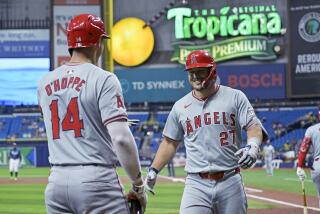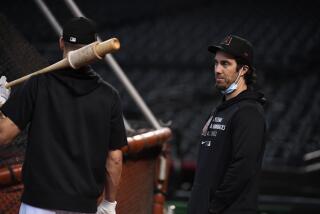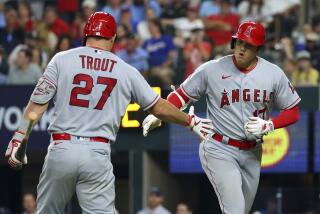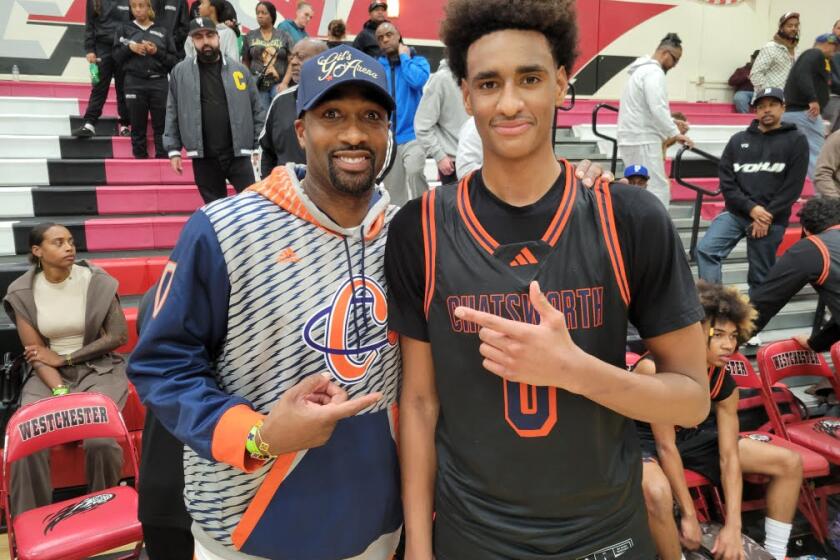A running concern for Angels pitchers in interleague play
Reporting from New York — The Angels begin a stretch of nine interleague games in National League parks when they play the New York Mets on Friday night, giving their pitchers a rare opportunity to try to get a hit. Any success, however, would create a good-news, bad-news situation for the team.
The good news: An Angels pitcher got on base.
The bad news: An Angels pitcher got on base.
It’s not so much the swinging or bunting or slashing and running to first that concerns Manager Mike Scioscia.
It’s what happens if they actually get to first base, where they might have to dive head-first back to the bag, break up a double play or go from first to home on a double and slide into the plate.
“These guys are pretty athletic, so things such as touching a base, running and making a left-hand turn, they should be able to handle,” Scioscia said. “As far as sliding, you just hope they react and slide.
“We talked about getting your arms up when you slide so you don’t strain a wrist or jam a shoulder. No head-first sliding. Get your hands up when you slide and pop up.
“There are a lot of pitfalls for National League pitchers too, but they generally get accustomed to them. So it is magnified for American League teams.”
Jered Weaver fancies himself a hard-nosed player, so after the Angels pitcher hit a third-inning single at Dodger Stadium on June 16, 2007, his natural instinct on Chone Figgins’ ensuing grounder to first base was to attempt to break up a double play.
But as he bore down on Dodgers shortstop Rafael Furcal, everything Weaver learned about proper sliding technique suddenly eluded him.
Weaver slid more on his side than his bottom and braced himself with his right arm, jamming his wrist and shoulder into the ground and suffering a minor dislocation of his shoulder.
Trainers popped the shoulder into place and Weaver remained in the game, throwing 5 1/3 scoreless innings, but he developed tendinitis in the shoulder that forced him to miss his next start.
Weaver returned to the rotation 11 days later but struggled in his next nine starts, going 2-3 with a 4.58 earned-run average.
“I learned to keep my arms up when I slide and to not try to run your elbow into the ground and jump at the guy,” Weaver said. “I was brought up playing the game hard, and I’m not going to change. If it gives us a chance to win, I’m going to slide again.”
Dan Haren and Joel Pineiro, who both played extensively in the National League, have by far the most hitting experience of the Angels’ top four starting pitchers.
Haren, who was Pepperdine’s designated hitter on the days he didn’t pitch in college, is one of baseball’s best hitting pitchers. He has a .226 career average (58 for 257), two homers, 21 doubles, 26 runs batted in and 18 sacrifice bunts.
He hit .364 (20 for 55) last season and had a four-hit game against St. Louis on April 20 before being traded from Arizona to the Angels in July.
Haren and Pineiro love playing in NL parks because they feel more a part of the game and can actually help themselves with the bat. But they both know they shouldn’t be too ambitious on the bases.
“If it’s a close game, you want to make something happen — that’s human nature,” Haren said. “For me, controlling my running is the key because 80% to 90% is just as good as 100%.
“We’re good athletes, but I don’t think we’re going to steal any bases. Having a good, smooth, controlled run is the best thing you can do on the bases.”
Pineiro is not as dangerous with the bat — he’s a .105 career hitter (17 for 162) with 93 strikeouts — but he has 20 sacrifice bunts and actually stole a base, something Haren, Weaver and Ervin Santana haven’t accomplished.
Last season Pineiro reached base three times — on two walks and a strikeout-wild pitch — and scored three runs in a 10-1 win at Dodger Stadium.
“The risks are not so much getting hit by a pitch, it’s more pulling hamstrings, twisting ankles and bumping knees when you’re sliding into a guy,” Pineiro said. “I haven’t been hurt [as a hitter or baserunner]. I don’t think I run fast enough to get hurt.
“But I have broken up double plays, and when you go in there you’ve got to go in hard. But it feels good when you go back to the dugout and get high-fives because you broke up a double play. It feels like you’re playing baseball.”
The best part of interleague play for most AL pitchers is the weeks leading up to it, when they get to pull sweatbands up to their forearms, spit into their batting gloves, and take batting practice before games.
Last week, long reliever Trevor Bell hit four balls over the wall in Angel Stadium and returned to the clubhouse grinning.
“Dippin’ and rippin’,” said Bell, who struck out in St. Louis last season in his only big league at-bat. “The swing feels good. I don’t know how 90 mph would look, but 75 mph is kind of easy.”
Haren waded through the bat box in Seattle the other day and pulled out one of Bobby Abreu’s club-like, 34 1/2 -inch, 33-ounce models. Haren uses a bigger, heavier bat “just in case I make contact,” he said.
Scioscia isn’t expecting much from his pitchers in the next nine games. Since interleague play began in 1997, Angels pitchers have combined to hit .120 (33 for 274) with no homers, five doubles, 14 RBIs, 13 walks and 107 strikeouts.
During spring training, Scioscia orders pitchers not to swing. But Haren, Weaver and the rest won’t be bat-holding statues in Citi Field, Florida’s Sun Life Stadium and Dodger Stadium.
“It’s important for pitchers to try to do what they can,” Scioscia said. “Start with little things like getting your bunts down, getting into a slash if they charge too hard, getting into a nice easy swing to put the ball in play and give yourself a chance to get a hit.”
The Angels have $36 million invested in their top four pitchers this season, which is why if they do get a hit, Scioscia will probably sound a lot like the old television show sergeant who, after briefing his officers in a meeting, always closed with these words:
“Let’s be careful out there.”
More to Read
Go beyond the scoreboard
Get the latest on L.A.'s teams in the daily Sports Report newsletter.
You may occasionally receive promotional content from the Los Angeles Times.











